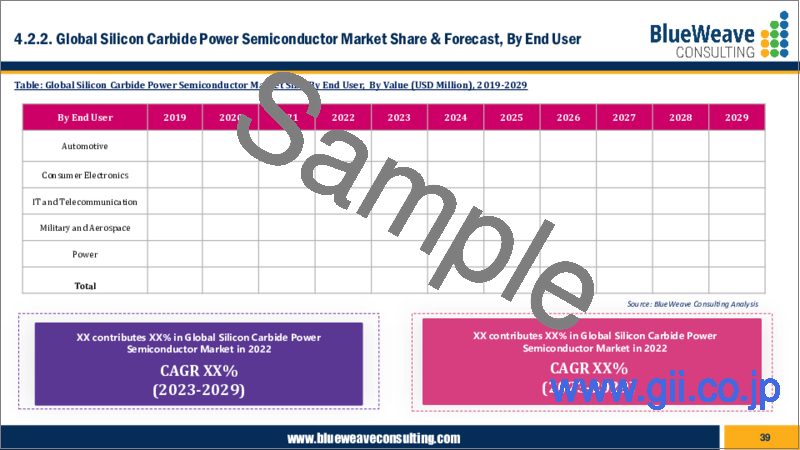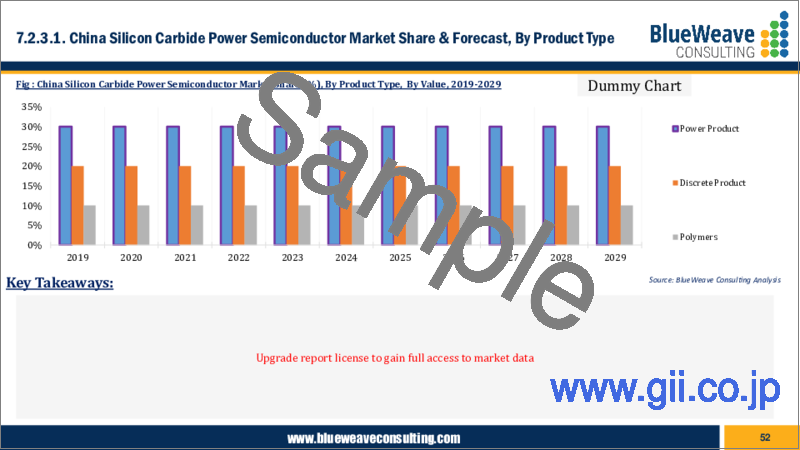|
|
市場調査レポート
商品コード
1208575
炭化ケイ素パワー半導体の世界市場 - 市場規模、シェア、動向分析、機会、予測:製品別、エンドユーザー業界別、地域別(2019年~2029年)Silicon Carbide Power Semiconductor Market - Global Size, Share, Trend Analysis, Opportunity and Forecast Report, 2019-2029, Segmented By Product ; By End-User Industry ; By Region |
||||||
| 炭化ケイ素パワー半導体の世界市場 - 市場規模、シェア、動向分析、機会、予測:製品別、エンドユーザー業界別、地域別(2019年~2029年) |
|
出版日: 2023年01月24日
発行: Blueweave Consulting
ページ情報: 英文 240 Pages
納期: 2~3営業日
|
- 全表示
- 概要
- 目次
世界の炭化ケイ素パワー半導体の市場規模は、2023年から2029年の予測期間中にCAGRで16.8%の成長が予測されています。世界の炭化ケイ素パワー半導体市場拡大の主な要因としては、IT・通信、航空宇宙・防衛、産業、エネルギー・電力、半導体・エレクトロニクス、自動車、ヘルスケアなど、さまざまな業界でパワーエレクトロニクスが使用されるようになっていることが挙げられます。
当レポートでは、世界の炭化ケイ素パワー半導体市場について調査分析し、市場の洞察、セグメント別・地域別の市場分析、競合情勢、主要企業のプロファイルなどの情報を提供しています。
目次
第1章 調査の枠組み
第2章 エグゼクティブサマリー
第3章 世界の炭化ケイ素パワー半導体市場の洞察
- 業界バリューチェーン分析
- DROC分析
- 促進要因
- ワイヤレス通信とコンシューマーエレクトロニクスの需要の高まり
- エネルギー効率に優れたバッテリ駆動の携帯機器に対する需要の高まり
- 抑制要因
- シリコンウェハーの不足
- 機会
- バッテリ駆動の携帯機器に対する需要の高まり
- 課題
- 促進要因
- 技術の進歩/最近の動向
- 規制の枠組み
- ポーターのファイブフォース分析
第4章 世界の炭化ケイ素パワー半導体市場概要
- 市場規模と予測(2019年~2029年)
- 金額別
- 市場シェアと予測
- 製品別
- パワープロダクト
- ディスクリート製品
- ポリマー
- その他
- エンドユーザー業界別
- 自動車
- コンシューマーエレクトロニクス
- IT・通信
- 軍事・航空宇宙
- 電力
- その他
- 地域別
- 北米
- 欧州
- アジア太平洋(APAC)
- ラテンアメリカ
- 中東・アフリカ(MEA)
- 製品別
第5章 北米の炭化ケイ素パワー半導体市場
- 市場規模と予測(2019年~2029年)
- 金額別
- 市場シェアと予測
- 製品別
- エンドユーザー業界別
- 国別
- 米国
- カナダ
第6章 欧州の炭化ケイ素パワー半導体市場
- 市場規模と予測(2019年~2029年)
- 金額別
- 市場シェアと予測
- 製品別
- エンドユーザー業界別
- 国別
- ドイツ
- 英国
- イタリア
- フランス
- スペイン
- オランダ
- その他の欧州
第7章 アジア太平洋の炭化ケイ素パワー半導体市場
- 市場規模と予測(2019年~2029年)
- 金額別
- 市場シェアと予測
- 製品別
- エンドユーザー業界別
- 国別
- 中国
- インド
- 日本
- 韓国
- オーストラリア・ニュージーランド
- インドネシア
- マレーシア
- シンガポール
- フィリピン
- ベトナム
- その他のアジア太平洋
第8章 ラテンアメリカの炭化ケイ素パワー半導体市場
- 市場規模と予測(2019年~2029年)
- 金額別
- 市場シェアと予測
- 製品別
- エンドユーザー業界別
- 国別
- ブラジル
- メキシコ
- アルゼンチン
- ペルー
- その他のラテンアメリカ
第9章 中東・アフリカの炭化ケイ素パワー半導体市場
- 市場規模と予測(2019年~2029年)
- 金額別
- 市場シェアと予測
- 製品別
- エンドユーザー業界別
- 国別
- サウジアラビア
- アラブ首長国連邦
- カタール
- クウェート
- 南アフリカ
- ナイジェリア
- アルジェリア
- その他の中東・アフリカ
第10章 競合情勢
- 主要企業とその製品のリスト
- 世界の炭化ケイ素パワー半導体企業の市場シェア分析(2022年)
- 競合ベンチマーキング:経営パラメータ別
- 主要な戦略的展開(合併、買収、パートナーシップなど)
第11章 世界の炭化ケイ素パワー半導体市場に対するCOVID-19の影響
第12章 企業プロファイル(企業概要、財務マトリックス、競合情勢、主要な人材、主要な競合、連絡先、戦略的展望、SWOT分析)
- Infineon Technologies AG
- Texas Instruments Inc.
- ST Microelectronics NV
- Hitachi Power Semiconductor Device Ltd
- NXP Semiconductor
- Fuji Electric Co. Ltd
- Semikron International GmbH
- Cree Inc.
- ON Semiconductor Corporation
- Mitsubishi Electric Corporation
- Microsemi Corporation
- General Electric Company
- Power Integration Inc.
- その他
第13章 主要な戦略的提言
第14章 調査手法
Global Silicon Carbide Power Semiconductor Market Size Expands at Impressive CAGR of 16.8% between 2023 and 2029.
Global silicon carbide (SiC) semiconductor market is flourishing because of rising demand for wireless communications and consumer electronics and increasing adoption for energy-efficient battery-powered portable devices.
BlueWeave Consulting, a leading strategic consulting and market research firm, in its recent study, expects global silicon carbide (SiC) semiconductor market size to expand at a CAGR of 16.8% during the forecast period between 2023 and 2029. Major factors for the expansion of global silicon carbide power semiconductor market include increasing use of power electronics in variety of industries including IT and telecommunications, aerospace and defense, industrial, energy & power, semiconductor & electronics, automotive, and healthcare. Power electronics focuses on ensuring the effective and efficient control and conversion of electrical power. SiC semiconductors, for example, aid in the control of automotive electronics, such as the electric braking system, power steering, and seat control hydroelectric vehicles main inverter. Power electronics is becoming increasingly popular. Power electronic devices are also used in energy conversion in aircraft actuators and generators. Also, SiC is one of the few compound semiconductors being considered for use in the production of power semiconductors for 5G communication. Moreover, rising demand for SiC semiconductors in renewable energy applications and hybrid vehicles is propelling the global Silicon Carbide Power Semiconductor market during the period in analysis. However, shortage of silicon wafers is anticipated to restrain the market growth.
Global Silicon Carbide Power Semiconductor Market - Overview
Silicon carbide is a hard, crystalline compound of silicon and carbide with the chemical formula "SiC." It can be found in nature as the extremely rare mineral moissanite. Silicon carbide grains can be bonded together to form hard ceramics that can be used in high endurance applications, such as car brakes, clutches, and ceramic plates in bulletproof vests. Carborundum is another name for silicon carbide. Since 1983, its powder has been mass-produced for use as an abrasive. Silicon carbide has a hardness level comparable to diamond, allowing carbide semiconductors to operate in harsh conditions. The increasing demand for power electronics across various industry verticals, such as IT & telecom, aerospace & defense, industrial, energy & power, semiconductor & electronics, automotive, and healthcare, is the primary factor driving the silicon carbide power semiconductor market. Silicon carbide power semiconductors are the most popular and are regarded as the best choice for electronics. These silicon carbide power semiconductors are used in a variety of applications, including the residential, commercial, and industrial sectors, among others. silicon carbide power semiconductors are available in two forms: Silicon Carbide discrete devices and Silicon Carbide bare die. The prevalence of silicon carbide discrete devices is increasing rapidly as a result of technological advancements. The significant property of the silicon carbide power semiconductor is high thermal conductive properties, as well as various others that efficiently use electricity. Silicon carbide power semiconductors are used in a variety of applications, including telecommunications, energy and power, renewable energy generation, and others. Silicon carbide power semiconductors are increasingly being used in power electronics, which is gaining popularity among individuals.
Global Silicon Carbide Power Semiconductor Market - By End-User Industry
Based on end-user industry, global Silicon Carbide Power Semiconductor market is segmented into Automotive, Consumer Electronics, IT and Telecommunication, Military and Aerospace, and Power. The automotive industry is expected to hold the highest market share. According to the US Department of Energy, a 10% reduction in vehicle weight can result in a 6-8% increase in fuel economy. Substituting cast iron and traditional steel components with lightweight materials such as high-strength steel, magnesium (Mg) alloys, aluminum (Al) alloys, carbon fiber, and polymer composites can decrease the weight of a vehicle's body and chassis by up to 50%, lowering fuel consumption. SiC semiconductors are ideal for plug-in hybrid (PHEV) and fully electric vehicle applications such as on-board chargers and inverters (EVs). This is due to their significantly higher energy efficiency when compared to traditional silicon. In addition, to ensure that EVs can travel long distances and charge quickly, the vehicle's power electronics must be able to withstand high temperatures. SiC semiconductors have an energy efficiency of more than 95%. Only 5% of the energy lost as heat during power conversion, such as charging the vehicle with a high-power rapid charger, is lost as heat.
Impact of COVID-19 on Global Silicon Carbide Power Semiconductor Market
COVID-19 had a detrimental impact on silicon carbide (SiC) semiconductor market since manufacturing facilities and services were closed as a result of the lockdown and COVID-19 governmental laws, the SiC power semiconductor industry witnessed a gradual decline in demand. Even private and public development has been halted. Furthermore, the industry was impacted by the disruption in the supply chain, particularly of raw materials used in the manufacturing process of SiC power semiconductors. Stringent government regulations for various industries, as well as trade and transportation restrictions, were among the top factors that slowed the growth of the global market for SiC power semiconductors in 2020 and the first two quarters of 2021. As a result of government restrictions around the world, SiC power semiconductor production slowed and did not meet demand in the first three quarters of 2020. There is a high demand/requirement for SiC power semiconductor products in the automotive and defense industries, the medical sector, and hydraulics applications. The resumption of production in the oil and gas industry and the automotive industry has fueled global demand for SiC power semiconductors. As a result, not only did demand rise, but so did the price of the product.
Competitive Landscape:
Major players operating in global silicon carbide power semiconductor market include: Infineon Technologies AG, Texas Instruments Inc., ST Microelectronics NV, Hitachi Power Semiconductor Device Ltd, NXP Semiconductor, Fuji Electric Co. Ltd, Semikron International GmbH, Cree Inc., ON Semiconductor Corporation, Mitsubishi Electric Corporation, Microsemi Corporation, General Electric Company, and Power Integration Inc. To further enhance their market share, these companies employ various strategies, including mergers and acquisitions, partnerships, joint ventures, license agreements, and new product launches.
The in-depth analysis of the report provides information about growth potential, upcoming trends, and statistics Global Silicon Carbide Power Semiconductor Market. It also highlights the factors driving forecasts of total market size. The report promises to provide recent technology trends in Global Silicon Carbide Power Semiconductor Market and industry insights to help decision-makers make sound strategic decisions. Furthermore, the report also analyzes the growth drivers, challenges, and competitive dynamics of the market.
Table of Contents
1. Research Framework
- 1.1. Research Objective
- 1.2. Product Overview
- 1.3. Market Segmentation
2. Executive Summary
3. Global Silicon Carbide Power Semiconductor Market Insights
- 3.1. Industry Value Chain Analysis
- 3.2. DROC Analysis
- 3.2.1. Growth Drivers
- 3.2.1.1. Rising Demand for Wireless Communications and Consumer Electronics
- 3.2.1.2. Growing Demand for Energy-Efficient Battery-Powered Portable Devices
- 3.2.2. Restraints
- 3.2.2.1. Shortage of Silicon Wafers
- 3.2.3. Opportunities
- 3.2.3.1. Rising Demand for Battery-Powered Portable Devices
- 3.2.4. Challenges
- 3.2.1. Growth Drivers
- 3.3. Technological Advancement/Recent Developments
- 3.4. Regulatory Framework
- 3.5. Porter's Five Forces Analysis
- 3.5.1. Bargaining Power of Suppliers
- 3.5.2. Bargaining Power of Buyers
- 3.5.3. Threat of New Entrants
- 3.5.4. Threat of Substitutes
- 3.5.5. Intensity of Rivalry
4. Global Silicon Carbide Power Semiconductor Market Overview
- 4.1. Market Size & Forecast, 2019-2029
- 4.1.1. By Value (USD Million)
- 4.2. Market Share & Forecast
- 4.2.1. By Product
- 4.2.1.1. Power Product
- 4.2.1.2. Discrete Product
- 4.2.1.3. Polymers
- 4.2.1.4. Others
- 4.2.2. By End-User Industry
- 4.2.2.1. Automotive
- 4.2.2.2. Consumer Electronics
- 4.2.2.3. IT and Telecommunication
- 4.2.2.4. Military and Aerospace
- 4.2.2.5. Power
- 4.2.2.6. Others
- 4.2.3. By Region
- 4.2.3.1. North America
- 4.2.3.2. Europe
- 4.2.3.3. Asia Pacific (APAC)
- 4.2.3.4. Latin America
- 4.2.3.5. Middle East and Africa (MEA)
- 4.2.1. By Product
5. North America Silicon Carbide Power Semiconductor Market
- 5.1. Market Size & Forecast, 2019-2029
- 5.1.1. By Value (USD Million)
- 5.2. Market Share & Forecast
- 5.2.1. By Product
- 5.2.2. By End-User Industry
- 5.2.3. By Country
- 5.2.3.1. US
- 5.2.3.1.1. By Product
- 5.2.3.1.2. By End-User Industry
- 5.2.3.2. Canada
- 5.2.3.2.1. By Product
- 5.2.3.2.2. By End-User Industry
6. Europe Silicon Carbide Power Semiconductor Market
- 6.1. Market Size & Forecast, 2019-2029
- 6.1.1. By Value (USD Million)
- 6.2. Market Share & Forecast
- 6.2.1. By Product
- 6.2.2. By End-User Industry
- 6.2.3. By Country
- 6.2.3.1. Germany
- 6.2.3.1.1. By Product
- 6.2.3.1.2. By End-User Industry
- 6.2.3.2. UK
- 6.2.3.2.1. By Product
- 6.2.3.2.2. By End-User Industry
- 6.2.3.3. Italy
- 6.2.3.3.1. By Product
- 6.2.3.3.2. By End-User Industry
- 6.2.3.4. France
- 6.2.3.4.1. By Product
- 6.2.3.4.2. By End-User Industry
- 6.2.3.5. Spain
- 6.2.3.5.1. By Product
- 6.2.3.5.2. By End-User Industry
- 6.2.3.6. The Netherlands
- 6.2.3.6.1. By Product
- 6.2.3.6.2. By End-User Industry
- 6.2.3.7. Rest of Europe
- 6.2.3.7.1. By Product
- 6.2.3.7.2. By End-User Industry
7. Asia Pacific Silicon Carbide Power Semiconductor Market
- 7.1. Market Size & Forecast, 2019-2029
- 7.1.1. By Value (USD Million)
- 7.2. Market Share & Forecast
- 7.2.1. By Product
- 7.2.2. By End-User Industry
- 7.2.3. By Country
- 7.2.3.1. China
- 7.2.3.1.1. By Product
- 7.2.3.1.2. By End-User Industry
- 7.2.3.2. India
- 7.2.3.2.1. By Product
- 7.2.3.2.2. By End-User Industry
- 7.2.3.3. Japan
- 7.2.3.3.1. By Product
- 7.2.3.3.2. By End-User Industry
- 7.2.3.4. South Korea
- 7.2.3.4.1. By Product
- 7.2.3.4.2. By End-User Industry
- 7.2.3.5. Australia & New Zealand
- 7.2.3.5.1. By Product
- 7.2.3.5.2. By End-User Industry
- 7.2.3.6. Indonesia
- 7.2.3.6.1. By Product
- 7.2.3.6.2. By End-User Industry
- 7.2.3.7. Malaysia
- 7.2.3.7.1. By Product
- 7.2.3.7.2. By End-User Industry
- 7.2.3.8. Singapore
- 7.2.3.8.1. By Product
- 7.2.3.8.2. By End-User Industry
- 7.2.3.9. Philippines
- 7.2.3.9.1. By Product
- 7.2.3.9.2. By End-User Industry
- 7.2.3.10. Vietnam
- 7.2.3.10.1. By Product
- 7.2.3.10.2. By End-User Industry
- 7.2.3.11. Rest of APAC
- 7.2.3.11.1. By Product
- 7.2.3.11.2. By End-User Industry
8. Latin America Silicon Carbide Power Semiconductor Market
- 8.1. Market Size & Forecast, 2019-2029
- 8.1.1. By Value (USD Million)
- 8.2. Market Share & Forecast
- 8.2.1. By Product
- 8.2.2. By End-User Industry
- 8.2.3. By Country
- 8.2.3.1. Brazil
- 8.2.3.1.1. By Product
- 8.2.3.1.2. By End-User Industry
- 8.2.3.2. Mexico
- 8.2.3.2.1. By Product
- 8.2.3.2.2. By End-User Industry
- 8.2.3.3. Argentina
- 8.2.3.3.1. By Product
- 8.2.3.3.2. By End-User Industry
- 8.2.3.4. Peru
- 8.2.3.4.1. By Product
- 8.2.3.4.2. By End-User Industry
- 8.2.3.5. Rest of LATAM
- 8.2.3.5.1. By Product
- 8.2.3.5.2. By End-User Industry
9. Middle East & Africa Silicon Carbide Power Semiconductor Market
- 9.1. Market Size & Forecast, 2019-2029
- 9.1.1. By Value (USD Million)
- 9.2. Market Share & Forecast
- 9.2.1. By Product
- 9.2.2. By End-User Industry
- 9.2.3. By Country
- 9.2.3.1. Saudi Arabia
- 9.2.3.1.1. By Product
- 9.2.3.1.2. By End-User Industry
- 9.2.3.2. UAE
- 9.2.3.2.1. By Product
- 9.2.3.2.2. By End-User Industry
- 9.2.3.3. Qatar
- 9.2.3.3.1. By Product
- 9.2.3.3.2. By End-User Industry
- 9.2.3.4. Kuwait
- 9.2.3.4.1. By Product
- 9.2.3.4.2. By End-User Industry
- 9.2.3.5. South Africa
- 9.2.3.5.1. By Product
- 9.2.3.5.2. By End-User Industry
- 9.2.3.6. Nigeria
- 9.2.3.6.1. By Product
- 9.2.3.6.2. By End-User Industry
- 9.2.3.7. Algeria
- 9.2.3.7.1. By Product
- 9.2.3.7.2. By End-User Industry
- 9.2.3.8. Rest of MEA
- 9.2.3.8.1. By Product
- 9.2.3.8.2. By End-User Industry
10. Competitive Landscape
- 10.1. List of Key Players and Their Offerings
- 10.2. Global Silicon Carbide Power Semiconductor Company Market Share Analysis, 2022
- 10.3. Competitive Benchmarking, By Operating Parameters
- 10.4. Key Strategic Developments (Mergers, Acquisitions, Partnerships, etc.)
11. Impact of Covid-19 on Global Silicon Carbide Power Semiconductor Market
12. Company Profile (Company Overview, Financial Matrix, Competitive Landscape, Key Personnel, Key Competitors, Contact Address, Strategic Outlook, SWOT Analysis)
- 12.1. Infineon Technologies AG
- 12.2. Texas Instruments Inc.
- 12.3. ST Microelectronics NV
- 12.4. Hitachi Power Semiconductor Device Ltd
- 12.5. NXP Semiconductor
- 12.6. Fuji Electric Co. Ltd
- 12.7. Semikron International GmbH
- 12.8. Cree Inc.
- 12.9. ON Semiconductor Corporation
- 12.10. Mitsubishi Electric Corporation
- 12.11. Microsemi Corporation
- 12.12. General Electric Company
- 12.13. Power Integration Inc.
- 12.14. Other Prominent Players
13. Key Strategic Recommendations
14. Research Methodology
- 14.1. Qualitative Research
- 14.1.1. Primary & Secondary Research
- 14.2. Quantitative Research
- 14.3. Market Breakdown & Data Triangulation
- 14.3.1. Secondary Research
- 14.3.2. Primary Research
- 14.4. Breakdown of Primary Research Respondents, By Region
- 14.5. Assumptions & Limitations




